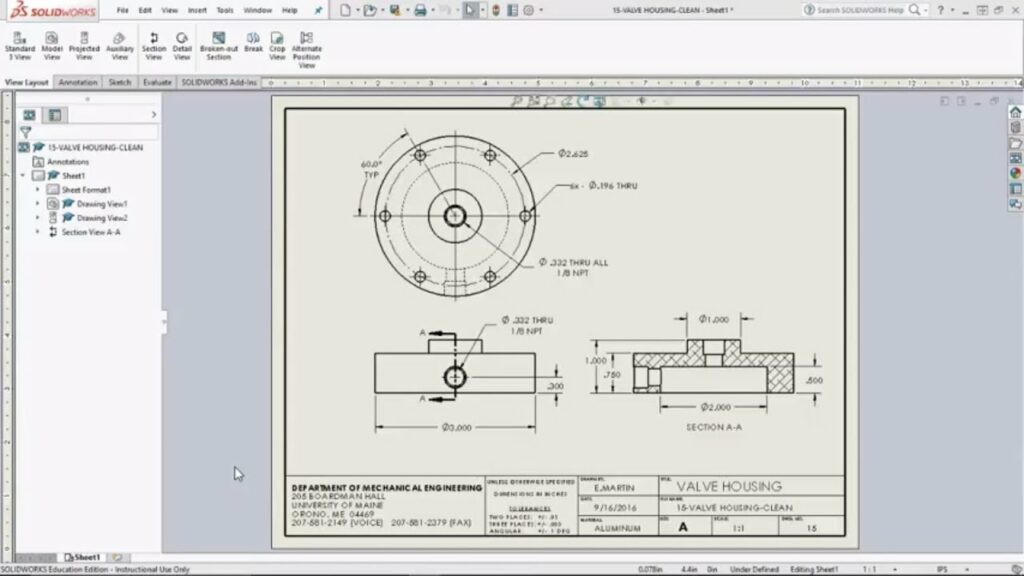Comprehensive Guide to Dimensioning Sketches in SolidWorks

Introduction: Dimensioning sketches is a fundamental aspect of creating precise and accurate designs in SolidWorks, a leading computer-aided design (CAD) software. Proper dimensioning not only communicates the size and shape of sketch geometry but also facilitates downstream processes such as modeling, analysis, and manufacturing. In this extensive guide, we’ll explore the intricacies of dimensioning sketches in SolidWorks, covering fundamental concepts, essential techniques, and advanced strategies to help you master this crucial aspect of CAD design.
Understanding Dimensioning in SolidWorks: Dimensioning in SolidWorks involves adding numerical values and annotations to sketch geometry to define its size, shape, and position accurately. Dimensions can be applied to various sketch entities, including lines, arcs, circles, and rectangles, using different dimension types such as linear, angular, and radial. Before delving into the specifics of dimensioning, it’s crucial to grasp some foundational concepts:
- Sketching:
- Sketching forms the foundation of design in SolidWorks, allowing users to create 2D profiles that define the geometry of parts and features. Sketch entities are drawn using tools such as lines, arcs, circles, and splines.
- Dimension Types:
- SolidWorks supports several types of dimensions, including linear dimensions (for measuring lengths), angular dimensions (for measuring angles), and radial dimensions (for measuring radii). Each dimension type serves a specific purpose in defining sketch geometry.
- Dimensioning Tools:
- SolidWorks provides a variety of dimensioning tools and options to facilitate dimensioning sketches accurately and efficiently. These tools include Smart Dimension, Ordinate Dimension, Baseline Dimension, and Chain Dimension, among others.
Dimensioning Sketches in SolidWorks: SolidWorks offers multiple methods for dimensioning sketches, each suited to different design requirements and preferences. Let’s explore the essential tools and techniques for dimensioning sketches:
- Smart Dimension:
- The Smart Dimension tool is the primary method for adding dimensions to sketch geometry in SolidWorks. Users can access Smart Dimension from the Sketch tab and apply dimensions by selecting sketch entities and specifying numerical values. SolidWorks automatically positions dimension lines and annotations for clarity.
- Ordinate Dimension:
- The Ordinate Dimension tool allows users to dimension sketch geometry relative to a common origin or reference point. Users can place ordinate dimensions horizontally or vertically, specifying distances along the X and Y axes. Ordinate dimensions are useful for organizing and referencing sketch geometry.
- Baseline Dimension:
- The Baseline Dimension tool enables users to dimension multiple sketch entities relative to a common baseline or reference line. Users can select a baseline and then add dimensions to adjacent sketch entities, creating a series of dimensioned segments. Baseline dimensions simplify the dimensioning process for complex sketches.
Advanced Dimensioning Techniques: In addition to basic dimensioning tools, SolidWorks offers advanced techniques to enhance dimensioning workflows and achieve precise design objectives:
- Dimension Driven Design:
- Dimension Driven Design is a methodology in SolidWorks that leverages parametric dimensions to drive design intent and update model geometry dynamically. By establishing relationships between dimensions and sketch entities, users can create designs that adapt to changes automatically.
- Equations and Global Variables:
- SolidWorks allows users to define equations and global variables to control sketch dimensions and parameters dynamically. Equations enable users to express mathematical relationships between dimensions, while global variables provide a centralized repository for managing design parameters.
- Tolerancing and Annotations:
- SolidWorks provides tools for adding tolerances and annotations to dimensioned sketches, ensuring clarity and compliance with design specifications. Users can specify tolerances for dimensions, add geometric tolerances, and include notes or symbols to convey manufacturing requirements.
Best Practices for Dimensioning: To maximize efficiency and maintain design integrity when dimensioning sketches in SolidWorks, it’s essential to adhere to best practices:
- Consistency and Clarity:
- Maintain consistency in dimensioning style and formatting throughout the sketch to enhance readability and comprehension. Use clear and concise annotations, avoid cluttering the sketch with excessive dimensions, and prioritize critical dimensions for clarity.
- Design Intent:
- Dimension sketches with design intent in mind, considering the functional requirements, manufacturing constraints, and assembly considerations of the design. Anticipate how changes to dimensions will affect the overall design and plan accordingly.
- Parametric Design:
- Embrace parametric design principles to create flexible and adaptive models that respond to changes dynamically. Establish relationships between dimensions and sketch entities, use equations and global variables to drive design parameters, and leverage Dimension Driven Design to maintain design intent.
- Dimension Checking:
- Regularly review and verify dimensions to ensure accuracy and consistency. Use tools like Check Sketch for Feature, Fully Define Sketch, and DimensionXpert to identify under-defined or over-defined sketches and resolve dimensioning errors.
Conclusion: Dimensioning sketches is a critical aspect of CAD design in SolidWorks, enabling engineers and designers to communicate design intent, ensure accuracy, and facilitate downstream processes. By mastering the tools and techniques for dimensioning sketches, you can enhance your design capabilities, streamline your workflow, and produce high-quality models that meet design requirements and manufacturing standards. Whether you’re a novice or an experienced SolidWorks user, understanding the principles of dimensioning and applying best practices will elevate your design proficiency and enable you to realize your design visions with precision and clarity.







